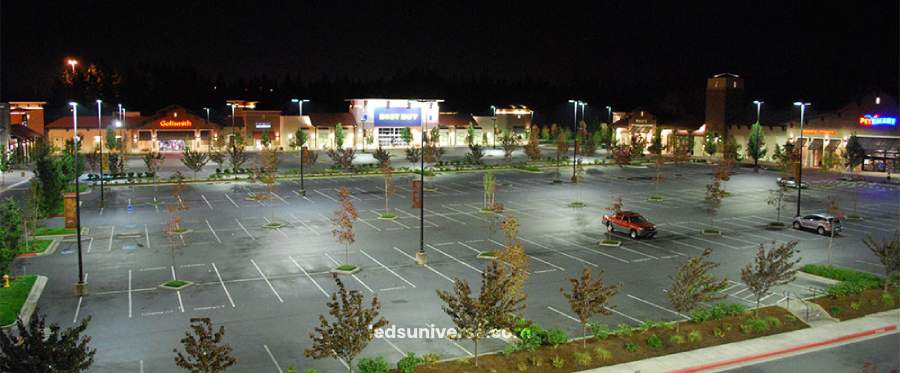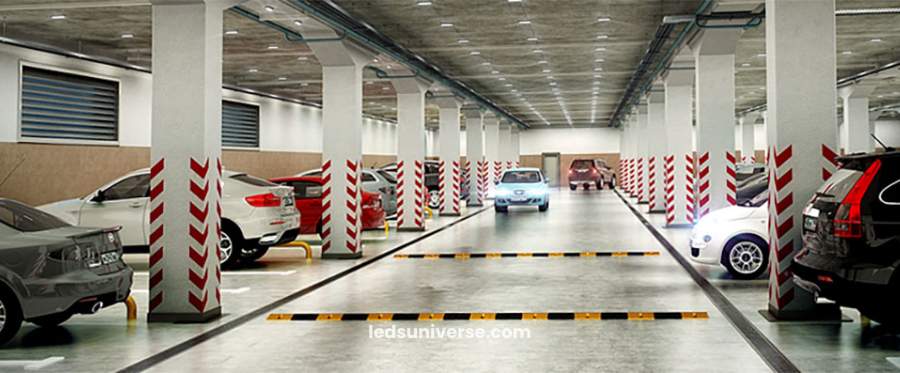Parking lot lighting is more than just a necessity—it’s a cornerstone of safety, security, and functionality in any modern facility. Imagine a bustling parking lot on a foggy evening, where every corner, pathway, and vehicle needs to be clearly visible. Well-designed lighting transforms this vision into reality, guiding drivers with ease and ensuring pedestrians navigate safely.
Effective parking lot lighting is not only vital for illuminating these spaces but also for optimizing energy efficiency and reducing operational costs. This becomes particularly important in large underground parking facilities, where lights are required to be on around the clock. Achieving a balance between effective illumination and energy efficiency can significantly impact the overall operational costs and user satisfaction.
Reach out for free lighting consultation
Table of Contents
ToggleCreating an efficient and cost-effective lighting system is paramount. The primary goals are to ensure safe and secure lighting levels for both vehicles and pedestrians and to prevent light pollution and interference with surveillance systems. Proper lighting design helps achieve these objectives by balancing illumination levels with energy efficiency.

LED lighting is favored for its exceptional energy efficiency and long lifespan. LEDs consume up to 80% less energy than traditional incandescent bulbs and can last over 50,000 hours. Their high luminous efficacy ensures bright illumination, enhancing safety and visibility in parking areas. Additionally, LEDs can be integrated with dimming and control systems, allowing for tailored lighting solutions that adjust based on traffic patterns and time of day, which further reduces energy consumption.
Metal halide lamps provide high-intensity, bright light with good color rendering, making them suitable for large parking lots. However, they are less energy-efficient compared to LEDs and have a shorter lifespan, leading to higher long-term costs.
High-pressure sodium lamps are cost-effective and deliver a warm light that is good for general illumination. They are less energy-efficient than LEDs and have poorer color rendering, but they remain a viable option for budget-conscious projects.

Effective parking lot lighting design starts with establishing the appropriate lighting levels for different areas of the parking facility. This is crucial for both safety and functionality.
For high-risk areas such as entry and exit points, it is essential to ensure a daytime horizontal luminance of at least 100 lux. These locations experience high traffic and are particularly vulnerable to accidents due to sudden changes in light conditions. Adequate illumination here helps drivers navigate safely and reduces the risk of collisions.
At night, the lighting requirements shift to accommodate reduced natural light. Traffic areas, which are active and require constant visibility, should be illuminated to a minimum of 60 lux. This level of illumination helps drivers see obstacles and pedestrians clearly, ensuring safe movement within the parking lot. In contrast, general areas, which are less trafficked and primarily serve as passive spaces, need only 30 lux. This lower level of illumination is sufficient to provide visibility without causing excessive glare or wasting energy.
Special attention is needed for high-traffic zones like payment desks, terminals, elevators, and staircases. These areas often see increased foot traffic and are critical for safe navigation. To address these needs, it is recommended to provide more intense lighting, with a horizontal luminance of 60 lux and a cylindrical illumination level of no less than 10 lux. This ensures that these areas are well-lit and easily accessible, reducing the risk of accidents and improving user experience.
Uniform lighting distribution is fundamental to creating a safe and visually comfortable environment in parking lots. Proper placement of fixtures and meticulous calculation of light distribution patterns are essential to avoid dark spots and ensure consistent illumination throughout the parking area.
Inadequate or uneven lighting can lead to dangerous situations, such as poorly lit corners or spots where visibility is compromised. To achieve uniform lighting, designers must consider factors such as the spacing of fixtures, their height, and the angle at which they cast light. Advanced lighting design tools and software can simulate different scenarios and help determine the optimal arrangement for fixtures to ensure even light coverage.
Effective lighting distribution also minimizes the risk of creating bright spots that can cause glare, making it difficult for drivers and pedestrians to see clearly. By employing a combination of well-placed fixtures and reflective surfaces, lighting can be evenly spread, reducing shadows and enhancing overall safety.
Glare is a significant concern in parking lot lighting design as it can impair visibility and create hazardous driving and walking conditions. To minimize glare, it is essential to use lighting fixtures that are shielded and positioned to direct light precisely where it is needed.
Fixtures should be equipped with shields or diffusers that help control the direction of light, preventing excessive brightness from spilling into unintended areas. This helps maintain clear visibility for both drivers and pedestrians, reducing the risk of accidents and improving overall safety.
Proper fixture placement and angle adjustments are also crucial in glare reduction. By carefully positioning lights at the correct angles, it is possible to direct illumination towards the parking area while avoiding direct exposure to drivers’ eyes. Additionally, the use of lower-intensity lighting in areas where high visibility is not as critical can further reduce glare and enhance the comfort of users.
Proper pole height and placement are crucial for achieving effective lighting in parking lots. Poles should be tall enough to ensure that light is distributed evenly across the entire area without creating shadows or obstructions. Typically, pole heights range from 12 to 30 feet, depending on the size of the parking lot and the desired coverage.
Choosing the right pole height involves considering the size of the parking lot and the type of lighting fixtures used. Taller poles can provide broader coverage and reduce the number of fixtures needed, while shorter poles might be suitable for smaller or more compact areas. The height of the poles should also account for the spread of the light, ensuring that the illumination reaches all areas of the parking lot without leaving dark spots.
The spacing between poles is equally important for achieving uniform illumination. Poles should be positioned to minimize gaps and overlap in lighting coverage. Proper spacing ensures that the light from each fixture blends seamlessly with that from adjacent fixtures, providing consistent brightness and eliminating shadows. Factors such as the type of fixtures, their beam angles, and the layout of the parking lot must be considered when determining the optimal placement of poles.
A reliable power supply and durable wiring are essential components of a successful parking lot lighting system. The power supply should be stable and capable of handling the electrical load required by the lighting fixtures. It is crucial to use weather-resistant materials for wiring and connections to ensure long-term performance and reduce the risk of electrical failures.
The power supply should be designed to accommodate the total wattage of all lighting fixtures in the parking lot. This involves calculating the electrical load and selecting appropriate circuit breakers and fuses. A well-maintained power supply helps prevent issues such as flickering lights or complete outages, ensuring that the parking lot remains well-lit at all times.
Wiring should be protected against harsh weather conditions, including rain, snow, and extreme temperatures. Using weather-resistant cables and connectors helps prevent damage and ensures the durability of the electrical system. Additionally, all electrical installations should meet local safety standards and codes to ensure safe operation and prevent potential hazards.
Regular maintenance and inspections are essential for keeping parking lot lighting systems in optimal condition. Routine checks help identify and address issues before they impact performance, ensuring that the lighting remains effective and reliable.
Scheduled inspections should be conducted to assess the condition of lighting fixtures, poles, wiring, and other components. These inspections help identify problems such as burnt-out bulbs, damaged fixtures, or loose connections. Promptly addressing these issues can prevent further damage and ensure that the lighting system continues to function properly.
Fixtures and poles must be designed to withstand harsh environmental conditions. An IP65 rating indicates that the fixtures are resistant to dust and water, making them suitable for outdoor use in various weather conditions. Materials used in the construction of lighting fixtures should be durable and capable of enduring exposure to elements such as rain, snow, and UV rays. This reduces the need for frequent replacements and ensures that the lighting system remains functional and reliable over time.
Energy efficiency is a key consideration in lighting design. LED lights are particularly advantageous, offering significant energy savings compared to traditional options. Incorporating lighting control systems and motion sensors can further enhance efficiency by adjusting lighting based on real-time needs.
Minimizing light pollution involves using fixtures that direct light precisely where needed, reducing spillage into surrounding areas. Shielding and directional lighting techniques help achieve this goal, balancing illumination with environmental considerations.
Parking lot lighting equipment must be dust-proof and water-proof, typically rated at IP65. Modern LED solutions, such as those from LedsUniverse, offer efficiency and adaptability, with options for various weather conditions. LEDs also integrate well with control systems and motion sensors, enhancing efficiency and reducing energy costs. For example, 100W LED parking lot lights can replace 400W metal halides, providing substantial savings.
LED lamps offer massive savings in both financial and energy terms, being ten times more economical than incandescent lamps and lasting nearly nine years. They provide uniform light coverage through optical polycarbonate lenses, ensuring even distribution. The aluminum construction of LED fixtures ensures durability against harsh conditions. Adjustable mounting options and a five-year warranty further underscore their reliability and low maintenance requirements.
By selecting the right types of lighting, considering design elements such as brightness and distribution, and following best practices for installation and maintenance, operators can create well-lit, safe, and cost-effective parking environments. Emphasizing energy efficiency and minimizing light pollution further enhances the functionality and sustainability of parking lot lighting systems. Investing in high-quality, adaptable lighting solutions, such as LEDs, ultimately supports operational goals and improves user satisfaction.